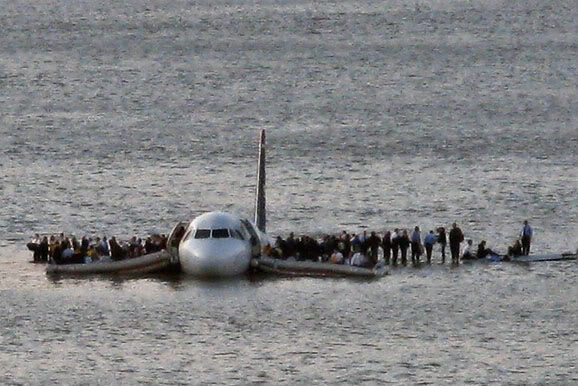On Jan 15, at 15.26LT, US Air flight 1549 (http://flightaware.com/live/flight/AWE1549), an Airbus A320 with 151 people (146 passengers and 5 crew members) on board taking off from La Guardia Airport in New York City to Charlotte, North Carolina, crashed into the water of the Hudson river after it failed the take off because of a birdstrike. The aircraft had climbed to 3.400 ft. As soon as the birdstrike occurred, the pilot headed back but fell in the water at 15.31, 5 minutes after take off. This is the track log as reported by FlightAware:
Time Position Ground
speed Altitude Facility
Eastern TZ Latitude Longitude kts Feet Location/Type
03:26PM 40.80 -73.87 151 1800 level New York TRACON
03:27PM 40.83 -73.87 174 2800 climbing New York TRACON
03:27PM 40.86 -73.88 194 3200 climbing New York Center
03:28PM 40.88 -73.90 202 2000 descending New York TRACON
03:28PM 40.86 -73.93 215 1600 descending New York Center
03:29PM 40.83 -73.95 194 1200 descending New York TRACON
03:29PM 40.82 -73.97 191 1300 climbing New York Center
03:30PM 40.78 -74.00 189 400 descending New York TRACON
03:31PM 40.75 -74.02 153 300 descending New York TRACON
Miraculously, there were no fatalities. According to what has been reported by the news reports, the pilot radioed the “Mayday” before approaching the water nose up, slow speed before touching the surface of the water in a slow contact. Fortunately, the airframe resisted the impact and US Coast Guard units and a ferry passing nearby dropped life jackets to the survivors. Some passengers were rescued from the slides on to boats, before the aircraft started to sink in to Hudson River. A dual engine failure during take off with subsequent crash landing in the water with no casualties is at least a sort of miracle. I couldn’t think a commercial aircraft could perform a sort of landing in the water after take off with such a Load Factor without breaking apart and floating for a certain amount of time permitting all the POB to escape safely. I think this is the first time a commercial aircraft ditched without any casualty. The pilot did an outstanding job. Furthermore, the aircraft tried to return to the airport after experiencing the emergency and it was able to land in the river even if it was overflying one of the most densely populated area of the world.
It also passed 500 feet above another aircraft N461SA during the left turn towards the impact point as La Guardia Airport Monitor replay show http://www4.passur.com/lga.html.
As I explained in a previous article dealing with the Ryanair B737 crash landing in Rome Ciampino airport because of a birdstrike on Nov 10 (https://theaviationist.com/2008/11/11/ryanair-b737-crash-landing/), the significant impacts with animals are somehow rare in commercial aviation but pose a threat especially during take off and landing phases. Because of birdstrikes, the Civilian Aviation suffers on average 1.2 billion dollars damages each year.












